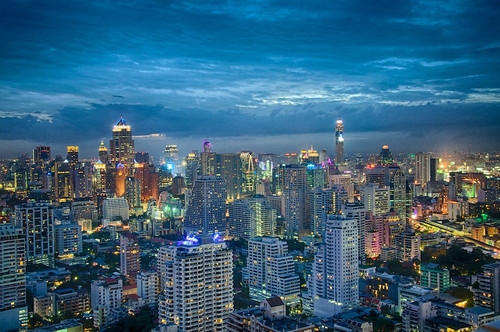A fresh look at Bangkok, rising Asian megacity (by Lee Epstein)

Posted March 19, 2014 at 1:26PM
I am a lover of cities, just as I am a lover of the natural world. When I travel, I can’t help but take note of how well cities and regions function. I recently had the opportunity to return to Bangkok, Thailand after 25 years.
(Lee Epstein is an attorney and land use planner working for sustainability in the Mid-Atlantic region, and a frequent contributor to this blog.)
As North Americans, we need to remain humble; we can always learn – even from places we might (sometimes wrongly) consider “less developed” than we are. In the US, we’ve done some things wonderfully right (like the National Park System or historic preservation in some cities). Some things we’ve done horribly wrong (like “urban renewal” in the 1960s, and its cousin, urban freeways). What’s going on elsewhere in the world?
Bangkok, 1988
Back then, it was a fast-developing city of about five million, and the country was seeing eight percent annual economic growth rates as multi-national corporate headquarters blossomed and the economy boomed. Bangkok then (and now) has typical Southeast Asian weather: extremely hot and humid most of the time, with a rainy season for a few months in the summer that becomes pretty impressive in the early fall.
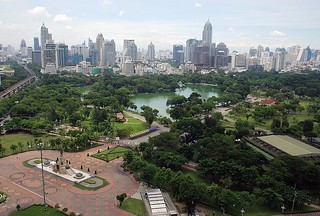 Vibrant and alive, Bangkok then had all the energy of a city on the move, and was a city of contrasts. Traffic was uniformly awful, sometimes literally choking in its intensity, with a predominance of dirty two-cycle and old diesel engines often clouding streets and skies. At the same time, there were many beautiful, quiet, and even spiritual parts of the city, from its lovely temples and palaces, and a few parks of moderate size (Lumphini Park, at a bit over 140 acres, is centrally located), to some peaceful low and mid-rise residential neighborhoods with gardens and trees.
Vibrant and alive, Bangkok then had all the energy of a city on the move, and was a city of contrasts. Traffic was uniformly awful, sometimes literally choking in its intensity, with a predominance of dirty two-cycle and old diesel engines often clouding streets and skies. At the same time, there were many beautiful, quiet, and even spiritual parts of the city, from its lovely temples and palaces, and a few parks of moderate size (Lumphini Park, at a bit over 140 acres, is centrally located), to some peaceful low and mid-rise residential neighborhoods with gardens and trees.
Of course, the well-off could always insulate themselves from some of the worst effects of pollution or heat, and even sometimes of flooding. Most of the populace, however, just got along, enjoying the economic and social benefits of this energetic city, and inuring themselves to daily conditions that could sometimes be very trying, unpleasant, and unhealthy.
Bangkok, 2014
And today? Bangkok is even bigger, a port city of more than eight million, with the city proper occupying some 300 square miles along the Chao Phraya River delta. Its metro region now sprawls unevenly into six adjacent provinces, comprising 14 million people -- almost a quarter of the country’s population. The city’s economy is strong, as it is a major Southeast Asian banking, business, and health care center.
It’s also one of the top tourist destinations in the world, attracting visitors from Europe, Asia, Russia, Australia, and the US to its ubiquitous shopping -- with more than a half dozen multistory malls like CentralWorld, with its 6 million square feet, I have never seen more or bigger urban (and some very upscale) malls within a single city, let alone surface markets like Chatuchak that extend over several city blocks.
And of course there is the city’s extensive nightlife; relatively unrestricted and somewhat renowned red-light districts; rich history and beautiful culture; and, of course, fantastic street food and thousands of restaurants. The city is still developing like crazy, with high-rise office and residential towers going up chock-a-block with small, exquisite temples, and ever more in-city malls offering luxury goods, on streets lined with tiny food stalls and vendors providing everything from kitchen hardware to clothes. Messy and often disorganized as one commentator recently noted? Absolutely. But it’s still a great city to wander. There remain substantial income disparities, but actual poverty is low.
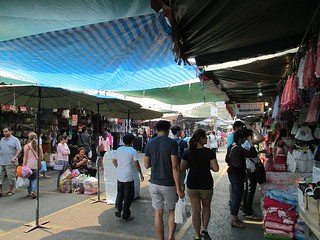 So are things better now, or worse, at least from the perspective of a sustainable city? Have the Thais tried to solve some of the problems that accompanied Bangkok’s fast rise: its sprawling and haphazard development; its once-crippling traffic and accompanying air pollution; and its sporadic “natural” disasters, both flooding and subsidence? What are its special strengths and weaknesses as a 21st century city, a place for human habitation and advancement?
So are things better now, or worse, at least from the perspective of a sustainable city? Have the Thais tried to solve some of the problems that accompanied Bangkok’s fast rise: its sprawling and haphazard development; its once-crippling traffic and accompanying air pollution; and its sporadic “natural” disasters, both flooding and subsidence? What are its special strengths and weaknesses as a 21st century city, a place for human habitation and advancement?
Transport
In 1988, the standing joke was an apology for being late for meeting friends for dinner, because traffic was awful. Back then, cabs jostled with motorbikes, buses, trucks, and “tuk-tuks” (3-wheeled motorized taxis), and heaven help the pedestrian. The city has tried to tackle the problem by building an above-street-level “BTS Skytrain,” a 20 mile, 30-station system of trains and walkways through central downtown that now carries 400,000 average daily trips (ADT). Bangkok also now has an intersecting 12 mile, 18-station underground subway system (the MRT), carrying some 200,000 ADT. There are new elevated freeways coursing through parts of the city. Both transit systems are efficient, modern and obviously well-used. A couple of the larger in-city canals provide regular water transit service and carry goods.
My take? While today’s traffic is still very bad during extensive rush hours, these systems have definitely taken thousands of vehicles off the roads (the city still, however, has one of the worst records for fatal traffic accidents, world-wide). Air pollution is also still bad, but the transit, together with more modern vehicle engines, has wrestled some of it back. In my view, the effects of these changes aren’t solely positive, however. Elevated Skytrain lines and freeways constitute massive urban infrastructure, in some places blocking views and light and introducing a poor aesthetic at the street level along those corridors.
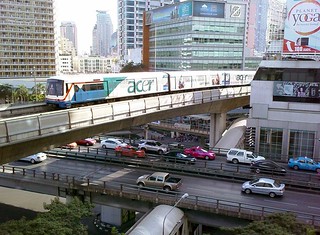 In the future, as mostly unrestricted development extends upward and outward in all directions -- even though there are plans to extend the existing transit systems -- mobility challenges will again intensify. Short of restricting vehicular travel in certain districts, however, or destroying miles of already existing development to insert new traffic/transit “solutions,” I’m not sure what else the City can do now or could have done differently to “fix” previous transport problems, although choosing a more orderly and better focused development plan over the past several decades might have helped.
In the future, as mostly unrestricted development extends upward and outward in all directions -- even though there are plans to extend the existing transit systems -- mobility challenges will again intensify. Short of restricting vehicular travel in certain districts, however, or destroying miles of already existing development to insert new traffic/transit “solutions,” I’m not sure what else the City can do now or could have done differently to “fix” previous transport problems, although choosing a more orderly and better focused development plan over the past several decades might have helped.
Flooding and Subsidence
As urbanization increased and the city buried more of its formerly pervious areas and hundreds of drainage canals (khlongs), and as climate change has brought heavier storms, regular flooding has increased. The remaining small canals still carry (very) polluted urban runoff when it rains. But inadequate storm drainage, inattentive urban design, and groundwater pumping have all helped exacerbate the city’s tendency to sink and slide into the fill that covers its marine clay sub-soils. Major floods have disrupted the city in recent years as the river delta brought water into the city, and runoff – with buried canals and very little green space -- has nowhere to go. My main prescription, and recommended climate change adaptation, would be to create more absorptive green space and stormwater systems citywide, and to pull back future development from the riverfront and canal frontage, recreating more floodplain. But honestly, that’s not going to happen.
Green Space, Urban Design and Development
In a word, there is little large green space, save the three park complexes totaling perhaps 700 or 800 acres, the private green space found among soccer pitches, schools and universities, and private property, and some tree-lined streets – overall, about a tenth the parks and open space per capita in New York City. In my own view, “people habitat” must include adequate parks and green space (we’ve talked about this before, here and here, for example). That’s not necessarily a tradition in a land where “green” means either cultivated land or tropical forest, with the latter’s sometimes not so friendly denizens. But I do believe that more of it, artfully inserted into high density areas, inevitably would make those centers more livable.
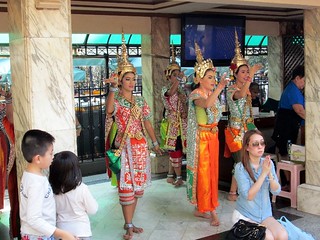 Urban design is also mostly lacking, as the city develops here and there in fits and starts, sometimes orienting that growth to its new transit systems, sometimes not. The seemingly unending, mostly unmanaged extension of growth into the countryside will exacerbate its problems. Maybe better up, like Vancouver, than out.
Urban design is also mostly lacking, as the city develops here and there in fits and starts, sometimes orienting that growth to its new transit systems, sometimes not. The seemingly unending, mostly unmanaged extension of growth into the countryside will exacerbate its problems. Maybe better up, like Vancouver, than out.
In the end, Bangkok will survive and prosper for some time. Whether this fascinating, full-spirited city will continue to thrive economically and socially in the following decades, however, as its population increases, sustainability challenges become more urgent in light of climate change, and its development profile remains stuck in high gear while livability gets squeezed still further, is an open question. Today the city still functions. It’s still an exciting, indeed crazy and mesmerizing place to visit. As a (rising) megacity on the front lines of coastal change, I hope it begins adapting sooner rather than later.
[A final note: Thailand, and Bangkok in particular, have been wracked over the past decade with occasional paroxysms of political upheaval. There are strong political divides that have fairly recently cracked open a society which had previously been fairly well-united under the royal family. While still revered, that institution has been weakened in recent years. At the same time, national political consensus has been split by a populist regime that has won several democratic elections but may have ruled corruptly; the prime minister has won the support of the least economically fortunate but has incurred the enmity of the middle and upper classes. There is also a north-south split, nationwide. Recent eruptions of political violence have turned ugly and deadly, with the “yellow shirts” seeking to undemocratically overthrow the prime minister (who is supported by the “red shirts”). It is too soon to tell where this will lead, but it is enormously sad to watch the confusion and violence in such a vital place.]
Other articles by Lee Epstein:
- The need for planning in the 'Southern Cone': a second look at Argentina (by Lee Epstein) (December 20, 2013)
- Wasting Away (by Lee Epstein) (November 26, 2013)
- Augusta's new master plan for revitalization looks like a winner (by Lee Epstein) (October 16, 2013)
- Whither intelligent vehicles and automated highways? (with Lee Epstein) (June 17, 2013)
- Is there a way to (downtown) San Jose? (by Lee Epstein) (May 6, 2013)
Move your cursor over the images for credit information.
Kaid Benfield writes about community, development, and the environment on Switchboard and in the national media. Kaid’s new book, People Habitat: 25 Ways to Think About Greener, Healthier Cities, is distributed by Island Press and available from booksellers nationwide.

